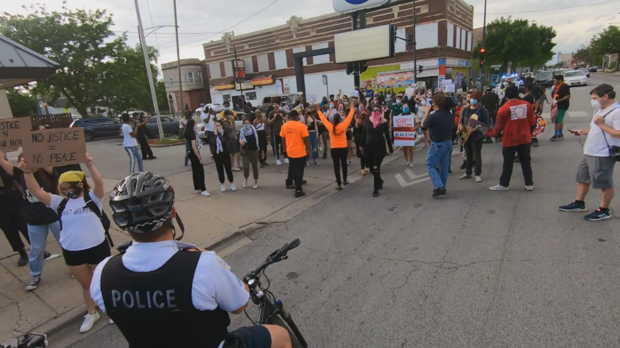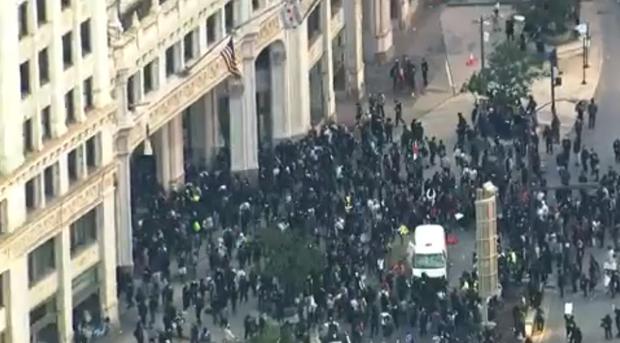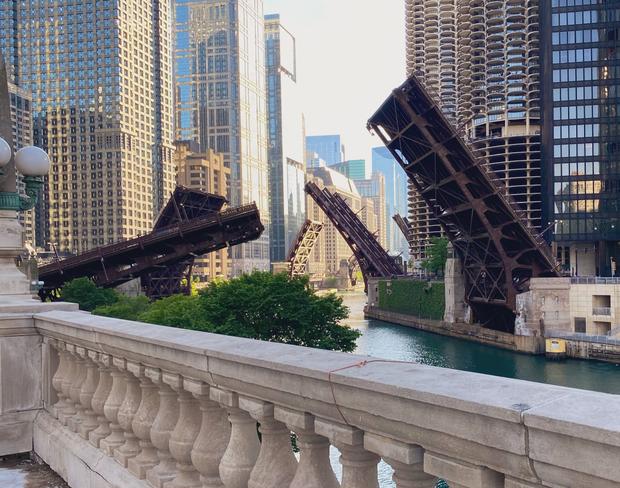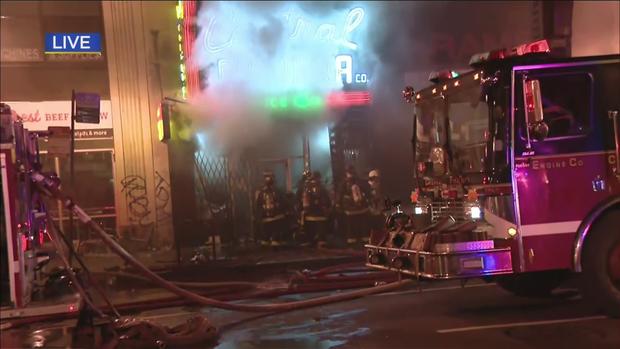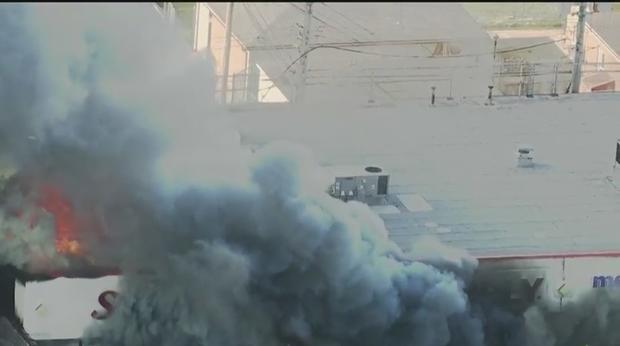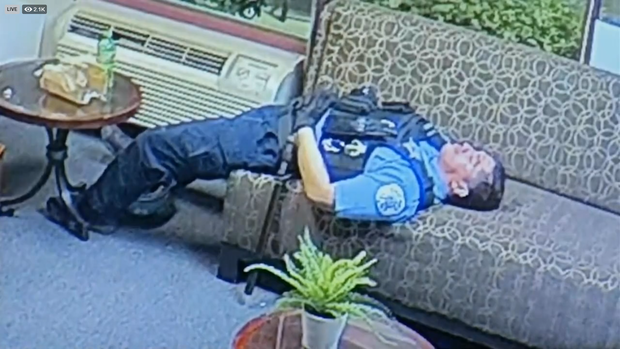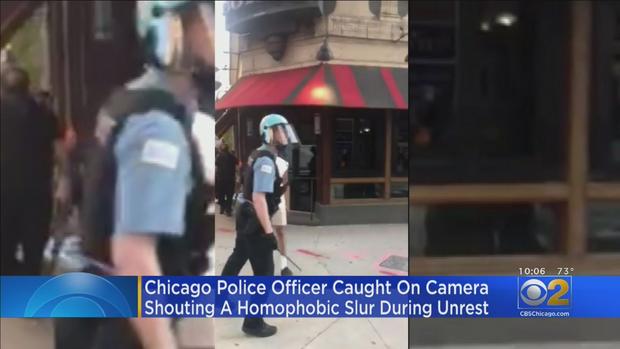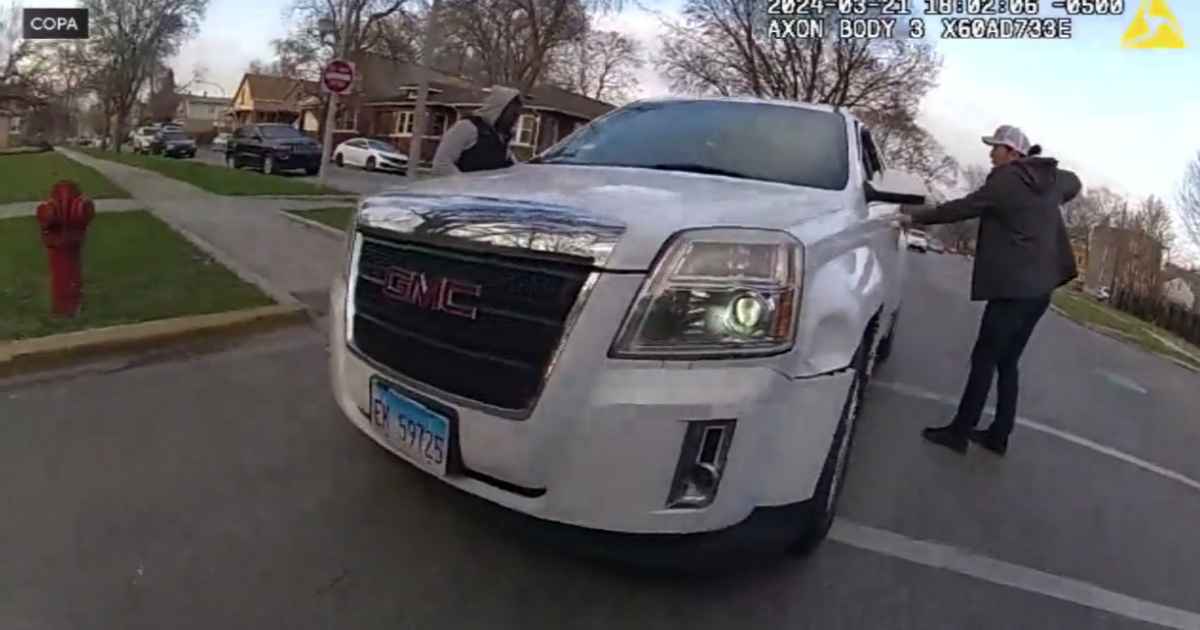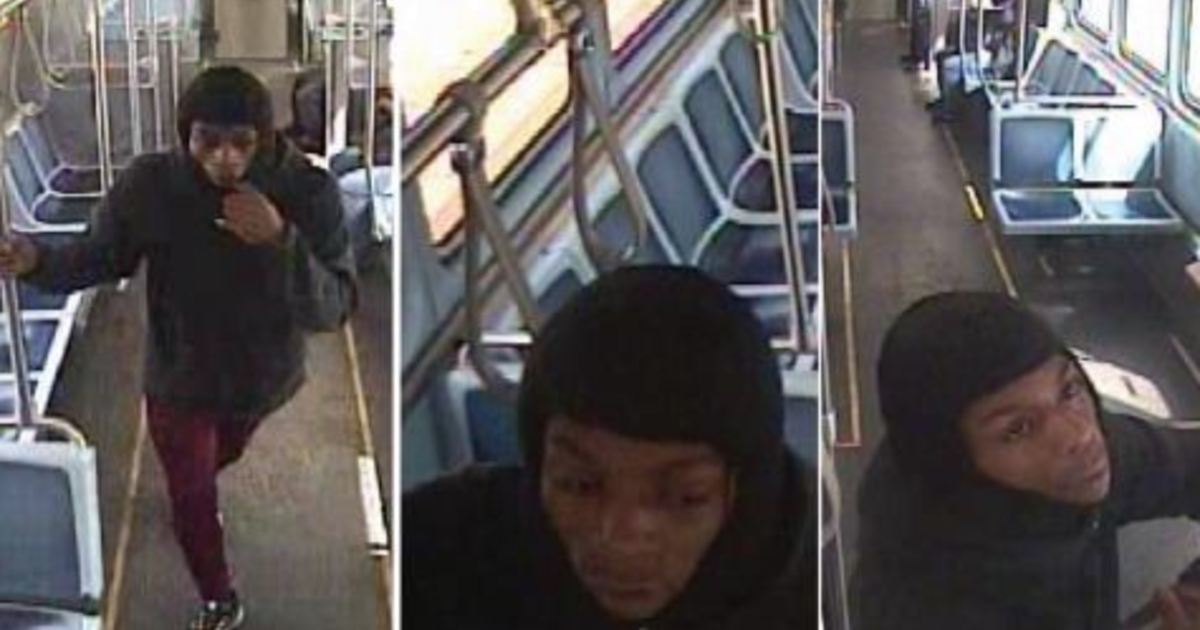Scathing Inspector General's Report Says CPD Was Unprepared, Disorganized, And Without A Plan During Civil Unrest In Wake Of George Floyd Protests In Chicago
by Adam Harrington, Megan Hickey
CHICAGO (CBS) -- The Chicago Office of the Inspector General on Thursday put out a scathing report of the city's handling of civil unrest that erupted amid protests following the death of George Floyd – concluding that police were unprepared for what happened and there was virtually no plan in place to handle it.
The report took the Police Department and the city to task for everything from a failure to follow mass-arrest procedures and document the use of force to a lack of organization and a general sense of confusion during the unrest. The report also documented numerous claims of mistreatment by police during the unrest.
Looting, arson, and violence erupted downtown on the evening of Saturday, May 30 – prompting Mayor Lori Lightfoot to issue a citywide curfew and the city to raise all but one of the Chicago River bridges. The following day, the unrest spread to Chicago neighborhoods.
The OIG report said police failed in their handling of both, and also criticized the police response to events before and after that weekend.
The OIG talked with city and CPD officials, rank-and-file officers and police supervisors, and protesters for the report.
Among the main findings of the report are that:
- Police officials reported they saw no indication that unrest was coming in Chicago, despite concerns from many officers and supervisors;
- The CPD did not have a sufficient plan to respond to civil unrest at any point when it was happening downtown and later in city neighborhoods;
- The raising of the Chicago River bridges during protests and unrest was undertaken on short notice and with great difficulty by the Chicago Department of Transportation;
- When Mayor Lightfoot announced a curfew, police were without guidance as to how to enforce it;
- The chain of command was unclear during much of the response to the unrest, so that assignments were unclear and some officers ended up just sitting around police stations;
- Procedures for mass arrests broke down;
- Use of force, including the deployment of pepper spray and the use of batons, was not properly documented;
- Police body cameras were not used for many arrests that happened during the unrest;
- Some officers obscured their names and star numbers in an act that undermined accountability.
Floyd was killed by Minneapolis Police on May 25, 2020. His death led to protests and civil unrest first in Minneapolis, then around the country including Chicago. In June 2020, the OIG and the Independent Monitoring Team overseeing a federal consent decree imposed on the Chicago Police Department launched a joint inquiry into the city's response to the unrest.
The inquiry concluded that police and city government did not plan for unrest, despite numerous indications that it was coming; and officers ended up "outflanked, under-equipped, and unprepared" to respond to the scale of the protests and unrest with which they were met in the downtown area and across Chicago's neighborhoods.
The report also criticized the city's response when some unrest also broke out during protests on the evening of Friday, May 29. The OIG said the police response "was marked by poor coordination, inconsistency, and confusion," and yet, senior police officials and the Mayor's Office reported calling the response something of a success or even a "win."
Meanwhile, rank-and-file officers and frontline supervisors told the OIG that the CPD did not seem adequately concerned that worse might be to come over the next couple of days, despite "obvious indications from news and social media."
The inquiry further concluded that the CPD was unprepared to deal with the volume of arrests that occurred during the period of unrest and failed to fulfill its obligations for reporting use of force. Moreover, the report said the police response to the unrest obstructed accountability – as there was "widespread non-compliance" with body-worn camera policies, in part because the officers were dispatched from a central point at Guaranteed Rate Field rather than their patrol stations.
But some of the obstruction was deliberate on some officers' part, the report said. There were complaints and evidence of officers obscuring their badge numbers and name plates, which the report said "profoundly compromised the investigation of allegations of misconduct." This was particularly true, the report said, when combined with the CPD's failure to keep track of where their officers were even deployed at any given time.
The Chain Of Events
The OIG report provided a detailed narrative of the events of late May and early June – which were widely documented in the news at the time. The narrative began on Tuesday, May 26, when protesters met outside CPD Headquarters at 3510 S. Michigan Ave. to call for justice for Floyd and to draw attention to mistreatment of Black and Brown communities by the CPD during the coronavirus pandemic.
Chance the Rapper, the Rev. Michael Pfleger, and activist Ja'mal Green were among those present. Chance the Rapper said at that protest: "This organized protest isn't a direct diss to CPD. It's not a diss to you guys' mayor. It's specifically standing in solidarity with the people in Minneapolis that are grieving."
The CPD Crime Prevention and Information Center (CPIC) had sent a notification throughout the department ahead of that protest, the OIG report said. Separately beginning on Wednesday, May 27, a senior official with the Civilian Office of Police Accountability reported that the office was hearing about and preparing for potential unrest in Chicago, the report said.
On the afternoon of Thursday, May 28, the CPIC sent a notification to some CPD command staff about a threat to burn down the Gresham (6th) District police station on open-source social media. The poster specifically wrote, "I wanna riot in Chicago and kill the police burn the sixth district police station dwn [sic]," the report said. This was hours before the Third Precinct police station in Minneapolis actually was burned during unrest there.
Police Supt. David Brown forwarded the notification about the threat to the police station to Mayor Lori Lightfoot and senior members of the staff, and the mayor in turn responded, "What is [happening] to the person who posted this threat?" the report said. The mayor subsequently wrote in response to an update on the investigation from the CPD Chief of the Bureau of Detectives: "Thanks, Chief. Please keep us posted. We cannot live in a world where someone posts such a threat without being held responsible," the report said.
That same day, there was a protest in Englewood calling for justice for Floyd. The CPIC had notified the Englewood (7th) District commander and the Area One deputy chief about the protest, but did not provide an estimate as to how many people would show up. The protest was described in the report as "contentious," with clashes between protesters and officers leading to one person being arrested while resisting.
The district commander used an arm bar to handcuff the person who was arrested after that person first ran away, and then locked their arms upon being caught, the report said. At least one senior member of the CPD took notice of the Englewood protest as evidence that "unusual events were unfolding," the report said.
Supt. Brown was aware of the incident and the district commander's use of force, but did not understand the link to a protest related to the Floyd killing, the report said. This was despite a notice that went out to CPD brass from the CPIC saying there would be a protest at 68th and Halsted streets in response to the events in Minneapolis, and also circulating a social media post about the event that featured the hashtag #JusticeforGeorgeFloyd, the report said.
Brown told the OIG and the Independent Monitoring Team in a subsequent interview that he "had not seen any reason for concern leading into that weekend," the report said.
But on the evening of Thursday, May 28, a senior aide to the mayor emailed Brown and several members of the CPD command staff – asking for a meeting on how to handle protests on Friday and through the weekend. The aide wrote, "[o]bviously, we're all a little concerned about what could happen this weekend given what we're seeing in Minneapolis," the report said.
Friday, May 29
On the morning of Friday, May 29, the CPD First Deputy Superintendent sent an email to CPD supervisors, asking them to attend roll calls beginning later that day to address the potential for spontaneous protests. A deputy chief emailed the district commanders under their supervision asking them to "personally address" their roll calls about the events in Minneapolis the report said.
There were reports of a planned protest Friday in Millennium Park, followed by another one at Federal Plaza on Saturday. Despite what happened in the Englewood protest, and unrest now occurring in other cities, senior CPD officials still reported they saw no indication that unrest would be happening in Chicago.
Meanwhile, department command staff received an intelligence notification from CPIC the day before about a planned protest on Saturday, May 30, in which the protesters planned to shut down Lake Shore Drive. The notification said an interstate highway in Los Angeles had also been shut down by a protest on Wednesday, May 27, but did not mention that police vehicles were vandalized and a protester was injured during the Los Angeles incident, the report said.
"Generally, over this period, CPIC notifications provided little mention of and no details about the protests and unrest occurring in other cities. One CPIC command staff member mentioned that national news media is one of CPIC's best sources of intelligence," the report said. "Despite the national protests and unrest, based on the intelligence provided by CPIC, the Department prepared for 'normal' protesting."
On Friday, May 29, CPIC notified the Central (1st) District commander and the Area Three deputy chief that a protest was planned for 6 p.m. downtown. CPIC identified the protest being related to Floyd's killing, but reported not having seen anything that would be a cause for unusual concern, the report said.
The CPD had been monitoring protests and unrest around the country, but command staff thought such unrest would not happen in Chicago – in part because it had not happened during protests over other events such as the release of the video of the shooting by a CPD officer that killed Laquan McDonald, the report said. One CPD command staffer said the department was growing "complacent" about protests, the report said.
The protest on Friday May 29, went ahead around 5:30 p.m. that day, and the OIG learned that the CPD did not plan a formal response for it. Around 30 people initially showed up, but more protesters joined – resulting in large-scale protests both sides of the Chicago River, the report said.
Protesters marched on Michigan Avenue and State Street and blocked traffic, and tried to march on the Eisenhower Expressway but were stopped from doing so by police, the report said. At the peak of the protest, abut 200 to 400 protesters were downtown – while the CPD fielded about 60 officers as the protests developed, the report said. The CPD had to deploy officers from elsewhere in the city.
As the night went on, vandalism did erupt. As CBS 2 reported at the time, several stores on State Street and Wabash Avenue were damaged with people breaking the glass windows. On State Street, the windows at Target, Macy's, Champs, Old Navy, and a nearby Dunkin' Donuts were all smashed. On Wabash Avenue, several stores were vandalized – including Windy City Diamonds, a local business that has been around for 90 years.
Chicago Police said more than 100 people were arrested and several officers were injured downtown that Friday night. Most of those arrested had disorderly conduct charges, but one was charged with aggravated battery. One officer suffered a broken wrist. About a dozen police vehicles across the city were also damaged with smashed windows or tires and spray paint.
The OIG report said early Saturday morning, CPD command staff had instructed officers on police radio to arrest anyone committing acts of vandalism. The report said groups of vandals had spread around downtown – requiring police to pursue them throughout with the help of Illinois State Police units.
An officer told the OIG that a commander ordered officers to push skirmish lines – sending some protesters north on State Street and some south.
"The Commander gave these orders without communicating a plan, aside from pushing protesters in opposite directions. The group being pushed south on State Street reached an area in which many officers had parked their CPD vehicles," the report said. "This led to a number of CPD vehicles being vandalized; protesters slashed tires and broke windows."
There were only two tow trucks available, so squad cars that were damaged had to swap tires with squad cars that had had their tires slashed so as to make at least some of them operational, the report said.
The report further said an executive officer had told investigators that on Washington Street between Dearborn and State streets, police responded to protesters walking in traffic by kettling them and blocking them into a large area while also telling them to leave. The vandalism began as the crowd began to disperse, the report said.
One officer told the OIG in an interview as part of the inquiry that the CPD's strategy on Friday night as "whack-a-mole," – involving officers running from scene to scene without a plan.
Records showed 112 people were arrested in all on Friday night into Saturday morning but the procedures involved in the arrests were described by an officer who had been at the scene as "confusing." The report said approved mass-arrest procedures such as documentation and arrestee processing were not used, and officers were told to go process their arrests at the police station lockup at the end of the night.
Despite the chaos and vandalism, some members of the CPD command staff said they believed the CPD had "won," and a senior staffer at the Mayor's office wrote: "Thank you all for your incredible work last night—you made Chicago proud," while Supt. Brown responded, "officers made the city of Chicago and the police profession proud!!!"
But some officers told the OIG that they were concerned about what would happen in the days to come.
Saturday, May 30
Some CPD command staff told the OIG they were worried about heightened tensions during protests on Saturday, but others expected protests would remain peaceful. The Area Three chief two days earlier had already requested extra resources for the protest in Federal Plaza on Saturday, and the First Deputy Superintendent sent an action plan to various members of the police brass about the event, the report said.
Large crowds were anticipated, so the CPD canceled regular days off for police Area teams and sent them downtown. Tactical and Area teams were told to report to McCormick Place at 2 p.m. and were expected to be on the scene downtown with helmets, batons, gas masks, and riot gear.
The protest was scheduled to start at 2 p.m. Police arrived ahead of that time by an hour or more, but at 1:50 p.m., a Central District commander reported that there were already 500 protesters in a rapidly-growing crowd in Federal Plaza, while a Deputy Chief estimated that thousands of protesters were already there by the time many of the officers arrived, the report said.
The CPD was using McCormick Place as a command center, and officers were taking Chicago Transit Authority buses north to the Loop. A command staffer told the OIG there was "no good plan in place for mobilization" of officers, the report said.
Multiple CPD command staffers told the OIG that the CPD had not set up its crowd control operation as the protest took off at Federal Plaza, and officers gathering at McCormick Place were needed right away, the report said. A command staff member told the OIG that police had been caught off guard and did not know the Federal Plaza protest's event time had been moved up.
Numerous members of the CPD command staff told the OIG the intelligence they received about the Saturday protest at Federal Plaza was "faulty or incomplete," the report said. A deputy chief said intelligence ahead of time had anticipated a few hundred protesters, and there ended up being 30,000 – with an estimate by a district commander that the crowd size doubled in five minutes. The report also said the CPD First Deputy Superintendent had received no intelligence indicating that civil unrest would be coming comparable to what had been seen elsewhere the country.
One officer told the OIG in that regard, the CPD "dropped the ball." Meanwhile, a sergeant reported getting no instruction from command staff as demonstrators were screaming "very personal" insults and calls for backup were issued.
Between 2 p.m. and 3:30 p.m., some protesters began heading north on Dearborn Street while others splintered toward Lake Shore Drive and marched east on Jackson Boulevard, the report said. An estimated 600 people headed north on Dearborn Street toward Trump Tower, while other protesters blocked traffic on the Drive, the report said.
As CBS 2's reporting at the time documented, a standoff ensued at Trump Tower. The CPD estimated the crowd there amounted to between 1,500 and 2,000 people, and some protesters began spray-painting bus shelters and damaging police vehicles there and elsewhere in the downtown area, the report said.
Officers described protesters throwing projectiles at them, spitting, and hurling verbal abuse, and also said protesters battered them, the report said. Meanwhile, protesters reported officers were using force indiscriminately, and said they saw CPD officers "tackle, punch, and use batons to strike peaceful protestors in the head and neck," the report said. Body cam footage supports some of those claims, the report said.
Trouble Ensues In Raising Bridges
The OIG said there were differing accounts of when the decision was made to raise the Chicago River bridges on Saturday. Mayor Lightfoot said she had decided to do so that day, while Supt. Brown said he had discussed it with the mayor the night before – with the goal of limiting the number of protesters who could get to Trump Tower.
A deputy chief said during a Saturday morning call with command staff, during which the raising of bridges was raised as a possibility, police did not know protesters were already downtown.
The Chicago River Bridges are under the domain of the Chicago Department of Transportation, and CDOT reported to the OIG that the Office of Emergency Management and Communications had called on either Thursday or Friday to discuss the possibility of raising the bridges that weekend – but there was "no standing plan to do so." There was also no advance notice given to CDOT personnel that they might be needed for such an operation, the report said.
CDOT said raising the bridges was a highly unusual emergency move, and had been rejected as an option during the 2012 NATO summit protests downtown on the grounds that it was ineffective for crowd control.
But Mayor Lightfoot decided to raise the bridges early Saturday afternoon, and CDOT reported they ran into problems in doing so. The bridges are raised on a regular schedule during the spring and fall months most of the time, but because the COVID-19 pandemic had shut down Lake Michigan harbors, the bridges had not been raised for some time as of May 2020, the report said.
Meanwhile, there had been heavy rain in Chicago in the weeks leading up to May 30, and some of the bridges' mechanisms had been flooded, the report said.
Still, CDOT called in off-duty personnel and sent them downtown to raise the bridges, the report said. In the process, vandals sprayed graffiti and broke the windows on a CDOT vehicle, the report said.
Once the crews started raising the bridges, they ran into numerous obstacles. On the Wabash Avenue Bridge that links the Loop to Trump Tower, debris was jamming the center deck – and CDOT crews had to clean it all out by hand and then crank the bridge open manually, the report said. Meanwhile, with such short notice about their mission, CDOT could only get two crews to raise two bridges at a time.
CDOT did raise all the bridges except the one at LaSalle Street, but it took until 7 p.m. to raise the Wabash Avenue Bridge. The report said. This was also because protesters were occupying the bridge in a standoff with police to keep them from getting to Trump Tower. Officers used batons to push protesters off the bridge and onto Lower Wacker Drive, but protesters said they never heard a dispersal order.
Protesters said they were beaten with batons, punched, and kicked as the officers tried to get them off the bridge.
As one protester was quoted in an interview with the OIG: "It felt like I was in the middle of a rugby scrum, squeezed between people and often being lifted off of the ground because the pressure of my body was so intense. I repeatedly told officers [to] stop pushing because someone behind me was having trouble breathing and was laying on the ground. I repeatedly told officers to stop pushing because they were hurting me. An officer hit my leg with a baton multiple times during an arrest of someone beside me who was dragged in, head-first, and thrown across the police line by police officers. Because of the police pushing, I was separated from the people that I came with, the people who would keep me safe."
The report indicated that Supt. Brown did not understand why raising the bridges was so difficult.
"The Superintendent asked whether there was a bridge operator in every bridge tower, and reportedly wondered whether there was not simply one person who could press a button and raise a bridge; he also inquired as to why CDOT needed tradespeople onsite," the report said.
CPD command staffers had mixed opinions as to whether raising the bridges was helpful.
CTA Service Suspension, Curfew, And Chaos
At 6 p.m., all CTA bus and train service was suspended in the downtown area. Service was halted as far north as Division Street, as far south as 35th Street, and as far west as Ashland Avenue.
The order came from the Mayor's office at the request of CPD senior command staff, who believed peaceful protesters had left downtown by then and also thought suspending train service would keep people from coming downtown to vandalize or loot stores. One command staff member specifically cited a need to prevent people coming downtown from the South Side, the report said.
Protesters who were still downtown said they ended up having trouble leaving given both the lack of CTA service and the raised bridges, the report said.
CTA staff also reported they were asked to do things that did not make sense – as police wanted people out of the downtown area, but all service had been stopped there. The CTA had to push to keep some buses running to get people out of downtown, the report said.
Around 8:22 p.m. Mayor Lightfoot imposed a citywide curfew from 9 p.m. to 6 a.m. until further notice.
"What started out as a peaceful protest has now devolved into criminal conduct. We have watched these protesters hurl not just words, bur projectiles at our police department; bottles of water, urine, and Lord knows what else," Mayor Lightfoot said in announcing the curfew.
The mayor also said shovels, bats, hammers, and lead pipes were wielded against officers.
Mayor Lightfoot characterized the approximately 35 minutes' notice for the curfew as "ample," the report said. Supt. Brown believed the curfew would be effective in stopping looting downtown and could provide probable cause to stop looters, the report said.
But the report said officers were not given any plan for this. Over police radio just after 9 p.m., someone announced that a curfew had gone into effect and that people should be arrested if they did not clear the streets, the report said. But officers who were downtown said their supervisors did not provide guidance about handling the curfew – including whether curfew violations were grounds for arrest, the report said.
Meanwhile, after the curfew announcement, hundreds of protesters took refuge at the Chicago Freedom School at 719 S. State St., the report said. School leaders let them stay there until they could get home, and provided snacks, water, and pizza, the report said. But before 11 p.m., the Department of Business Affairs and Consumer Protection and police officers entered the school and ordered them to cease and desist for distributing the food without the proper license – threatening daily fines of up to $1,000, the report said.
The Chicago Freedom School ended up suing the city over this, and the city ended up settling the lawsuit and rescinding the cease-and-desist order in July, the report said.
Back on the streets, protesters were growing out of control – as documented by CBS 2's reporters. Hours before the curfew was announced, graffiti was being spray-painted on buildings and vehicles around the downtown area and police vehicles were being set on fire – in some instances with live ammunition exploding inside.
Widespread looting throughout the Loop and South Loop began around 7 p.m. and continued into the early-morning hours Sunday. At Macy's at 111 N. State St, all display cases and racks were picked through and left empty, and all the glass was smashed. One commander said that every business downtown north of Roosevelt Road was looted, and looting also took place at stores to the north along the Magnificent Mile.
At least two downtown stores were also set on fire – the Chicago Sports store at 332 N. Michigan Ave. and Central Camera at 230 S. Wabash Ave.
A total of 101 officers were injured, according to the OIG.
The OIG report said the CPD had a few mobile teams downtown the whole time – with one command staff member saying the department had only 10 cars. CPD members responded to one looting incident after the next, trying to clear stores by making dispersal orders or arrests. Over the police radio, officers were told to make arrests after a group of officers did not arrest anyone when looting was happening in front of them, the report said.
A total of 130 people were arrested in the Central (1st) and Near North (18th) districts between midnight and 5 a.m. Sunday. Meanwhile, a total of 86 businesses in just the Near North District north of the River were damaged, the report said.
Supt. Brown told the OIG that the department ran into staff limitations because they couldn't give up the line at Trump Tower and did not have the manpower to prevent looting downtown. He said the CPD did later approve the use of pepper spray on looters who became violent, the report said.
One protester reported seeing looters who were "mostly kids" on State Street – and said the looters would break into a business with officers watching and not trying to catch them until they left. The protester reported seeing one looter who looked to be about 13 being arrested and having their face rubbed in glass on the sidewalk, and also said four officers were seen beating one kid.
The protester expressed confusion about why police were allowing looters to break into stores and then only trying to arrest one kid, the report said.
"(The protester) had never seen humans acting so violently against each other and was struck by seeing CPD officers take out their anger on kids; (the protester) said, 'I will never forget that, between the explosions, the blood, the glass,'" the report said.
Body cam footage also documented numerous other instances of aggression by officers. In one instance, the report said, "after a radio call related to a car pursuit, an officer can be heard telling other officers that CPD should just shoot the tires out and shoot the occupants of the vehicle in the head."
The report in particular criticized what it said was an unclear chain of command for handling the unrest on Saturday night. Normally ahead of a large protest, the CPD Special Events Unit will create an incident action plan that names an incident commander who in turn directs the operation. But that Saturday night, the report said, CPD officers and supervisors either did not know who the incident commander was or identified different people as being responsible for the role – ranging from Supt. Brown to the Central District commander.
There had been an incident plan distributed by the First Deputy Superintendent on Friday that named a certain deputy chief as an incident commander, but the report said officers on the scene did not widely understand this.
The incident action plan also failed to provide specific tasks for different CPD units, and there was no other formal plan that did so, the report said. Some CPD staff did not seem to see this as a problem.
"Two senior CPD members highlighted the Department's 'experience' in handling large protests, explaining that this experience allows the Department to respond to protests without formalizing a plan," the report said. "Still other CPD members, including those with some experience with large crowd events, believed that protests are dynamic and therefore impossible to plan ahead. One member of CPD's command staff offered, apparently by way of explanation, that there was no way for CPD to have predicted the unrest and looting that occurred Saturday."
One district commander said their officers were insufficiently supervised, and even radio communications expressed frustration at Mayor Lightfoot and the command staff, the report said.
The report further said officers complained "white shirts," or supervisors, were unwilling to take charge – and veteran rank-and-file officers had to direct themselves.
As the day went on, the CPD began converting the Summer Operations Center at the OEMC into an emergency operations center – which housed not only CPD officers, but representatives from the Mayor's office, the Illinois State Police, the National Guard, the CPD SWAT team and Intelligence Division, and the Department of Streets and Sanitation, among other units, the report said.
But the OIG reported the Emergency Operations Center did not have a sufficient system in place to keep track of where officers were being deployed, and many officers from around the city ended up self-deploying downtown and working without assignments or direction from any supervisor or the Emergency Operations Center.
Sunday, May 31
Early Sunday morning, a senior police official discussed a "perimeter plan" by email with senior CPD command staff and the Mayor's office, under which the Central Business District would be completely blocked off using salt trucks, garbage trucks, and other barriers, the report said.
Later in the morning Mayor Lightfoot said downtown access would be limited to those who lived and worked in the area and public transit would be shut down into and out of the Loop, and the 9 p.m. curfew would be extended indefinitely.
Meanwhile, an incident action plan was in place for another planned protest at Federal Plaza on Sunday, but for no other events. The CPD canceled regular days off for all officers and assigned them to 12-hour shifts – but directions for how the officers would be deployed were not handed down to officers until the late morning at the earliest, the report said.
On Sunday morning, the CPD started staging its citywide mobilization efforts at Guaranteed Rate Field. The officers were to be deployed throughout the city as needed, the report said.
Command staff instructed officers to form platoons in accordance with their normal command structure, but this did not always happen – and a deputy chief said there was no roster of leaders or estimate of how many officers would be there, the report said. One officer called the Guaranteed Rate Field operation a "clusterf**k," and said the platoon they were in sat around under a lamppost in the parking lot until finally getting deployed at 9 p.m. Sunday.
Police also found themselves in trouble when it came to transportation on Sunday, as so many squad cars had been damaged or destroyed the night before. The department tried to rent 150 vans for officer transport, but the rental company did not have that many available – so CPD personnel traveled around Illinois to get them from a dozen different locations and drive them back to Chicago, the report said.
Meanwhile, Illinois Gov. JB Pritzker on Sunday ordered 375 National Guard troops to support Chicago Police following violent protests the night before. Mayor Lightfoot said she decided to call Pritzker late Saturday night to request the National Guard after Supt. Brown said more resources were needed, and has "pointedly disputed" any claim that the state reached out to the city before that.
Late on Sunday, the city asked for another 250 National Guard troops. A senior state official told the OIG that the state first sought to have the National Guard operate as a military police force, but the city did not ask the National Guard to patrol city neighborhoods on Sunday because they did not want the National Guard using police powers – and the CPD was already worried about a militarized appearance in city neighborhoods, the report said.
The National Guard ended up handling control of access to downtown, with the help of Illinois State Police.
There were peaceful protests on Sunday at Daley Plaza, Chicago Public Safety Headquarters, and around the South Side – but also numerous acts of looting, arson, and vandalism in city neighborhoods that started between 10 and 11 a.m., the report said. Supt. Brown said the CPD had not received intelligence that looting might spread to the neighborhoods, and there were no events in other cities that foreshadowed such events.
On Sunday afternoon, CBS 2 documented numerous acts of looting around the city – particularly in large swaths of the South and West sides. Arsons were also reported at various locations.
The OIG reported the CPD had no plans in place to deal with the looting, and district commanders said their districts were in "complete chaos" – with one commander calling the situation worse than downtown the day before.
Violence also broke out, with shootings between gangs and shots being fired at CPD officers in the Ogden (10th) District on the West Side.
"Several District Commanders reported that there was little they could do to stop the looting because they were outnumbered. One District Commander estimated that they had 50 officers for around 300 to 500 looters, but they still attempted to make arrests. This Commander recounted seeing a group of people using moving trucks to loot business after business," the report said.
One CPD director reported waking up to a panicked call from an alderman that a Walmart was being looted. But there were not enough officers to go into the business and control the situation, and the director said if an officer had used deadly force to protect a store, the CPD would have "lost the city."
Many district commanders asked for backup from the Guaranteed Rate Field mobilization center, and some complained the officers took too long to arrive. When the officers did arrive, the district commander assigned them to a location – but some platoons arrived without any notice to the district commander and they ended up sitting around at the police station, the report said.
Further, platoons got to districts on CTA buses and could only walk places once they were dropped off the report said.
The following morning, Mayor Lightfoot emailed senior leadership at the CPD and the OEMC requesting statistics on how many calls had come in and how many were for looting among other information. The mayor wrote: "We need to be able to demonstrate that in fact police were assigned to the South and West sides because the narratives that we saved the downtown and let Black neighborhoods burn persists. Of course, totally untrue, but it persists."
Subsequent Days
On Monday, June 1, Gov. Pritzker declared Cook County and eight other counties disaster areas because of the unrest and vandalism. This made it easier to obtain resources needed to respond to the disaster and directed state agencies to move staff on an emergency basis, the report said.
Protests continued throughout the city for the rest of the week – but yet again, the First Deputy Superintendent put out an incident plan only having to do with a protest at Federal Plaza, the report said.
On Monday, there were protests at police district stations, Mayor Lightfoot's home in Logan Square, and downtown; and on Tuesday, a group of 3,500 to 4,000 protesters marched from Belmont Avenue and Halsted Street in East Lakeview to Broadway and Sunnyside Avenue in Uptown. There was still some looting on subsequent days, but it began to subside, the report said.
Meanwhile early on the Monday morning, video footage from the campaign office of U.S. Rep. Bobby Rush (D-Illinois) at 5401 S. Wentworth Ave. showed officers lounging, napping, making coffee and popping popcorn in the office. Rush said this happened while nearby businesses were being looted, and Mayor Lightfoot in subsequent days condemned the officers and said they would be held accountable.
"These police officers essentially took the night off while all hell was breaking loose all around them, while their colleagues were literally getting beaten up and injured all across the city," Lightfoot said several days later, adding that it was "utterly insulting" that the Chicago Fraternal Order of Police has claimed Rush invited the officers into his office, a claim Rush has said is not true.
The report said several officers complained to the OIG about the mayor's comments. The OIG was also told by another officer that the officers in the video were assigned to the area and were protecting it, and had been told to get rest when possible, yet were "publicly humiliated by the mayor."
Fraternal Order of Police President John Catanzara said 17 officers were suspended as a result of that incident, the report said.
Meanwhile on Monday, a social media post purporting to announce a plan to "burn the Northside to ashes" circulated among the CPD and City Hall leadership. Mayor Lightfoot forwarded the post to Supt. Brown and said the child of an alderman had seen it online. The mayor wrote: "I want to find and [arrest] the people who are propagating this nonsense. This is not protected speech."
On Tuesday, the CPD circulated a new and more detailed incident action plan that was focused on more than just Federal Plaza, but it was not widely used and a ranking command staffer called it "useless," the report said.
But many CPD command staff members reported that the CPD's operations and deployments improved as the week went on.
Meanwhile, 12-hour shifts and canceled days off for officers continued through that week despite complaints.
Downtown transportation routes reopened on Wednesday, June 3, but the curfew continued through the following weekend. On Friday June 5, a large protest began at Union Park for which CPD documentation indicated there was "extensive planning and coordinating," including requests for personnel, cameras, drones, and salt and tow trucks. The protest march occurred peacefully and without incident.
As quoted in the report, Mayor Lightfoot said of the unrest: "There was a level of sophistication that we saw in some of these groups that were clearly coming to these protests for a fight... [T]his was clearly a concerted effort to bring chaos to our cities. Who were these people?... [T]his was a conspiracy, sophisticated, paid for and promoted by someone in multiple cities across the country at the same time. That's not a coincidence."
The report did not address looting or unrest that happened later in the summer, such as the looting that hit the Loop, the Magnificent Mile, and several other areas early on the morning of Monday, Aug. 10.
The OIG's Findings And Conclusions
The OIG criticized the CPD on a number of fronts for its response to the unrest. The OIG said the mass arrest process that has formal guidelines in place broke down, because the CPD was unprepared to deal with a situation where officers had to arrest more than 1,000 people in concentrated time periods over just two days.
"As a result, arrestees were held without proper processing providing the substantiation for the reason for and duration of their detention, with some eventually being released without charges, and some being charged with something either less or more serious than their actual conduct may have warranted," the report said. "Moreover, the safety of arrestees and officers was threatened by the lengthy delays in transportation and processing and, finally, officers arrested fewer offenders than they might have otherwise due to the long transportation and processing times."
The report said further that the CPD failed to train officers of all ranks adequately in mass arrest procedures – and there was monumental confusion about it throughout the crisis. The report said many officers said they had never seen or filled out a mass arrest card.
Of the more than 1,500 arrests officers made between May 29, and June 7, 2020, only a small fraction actually documented.
A consequence of the failure to go by a plan for mass arrests was that many people wo were arrested ended up being released without charges – including upwards of 90 percent of those who were brought into Area Three headquarters at Belmont and Western avenues. On Saturday, May 30 alone, 54 out of 74 people who were arrested and processed there were released without charges, the report said.
Meanwhile, a senior CPD member said another consequence of the breakdown of mass arrest procedures and inadequate documentation was that some people were charged with low-level disorderly conduct when a more serious charge such as looting was warranted, the report said. The opposite problem was also evident – some people who were arrested may have been charged when no charge was appropriate, the report said.
In one instance, a protester said they were being transported in police custody when an officer wrote charges on their arm – despite not having been the officer who arrested them and not knowing the circumstance of their arrest, the report said.
Some officers also released people for such offenses as burglarizing a 7-Eleven because transport vehicles were too slow in getting to the scene and the officers did not want to wait, the report said.
Further, the OIG concluded that the CPD failed to fulfill its obligations on reporting the use of force throughout the unrest – particularly with regard to the use of pepper spray.
The OIG reported pepper spray was used at least two dozen times for crowd dispersal. Supt. Brown said he only approved the use of pepper spray when it was clear that people were trying to hurt officers – which would mean pepper spray would not be acceptable for controlling crowds or stopping looting, the report said.
Brown also said he never gave a blanket authorization for the use of pepper spray but did give a "general authorization" for some limited time periods of widespread looting and violence on Saturday, May 30, and Sunday, May 31.
But the OIG report said few, if any, command staff concurred with the threshold for the use of pepper spray being an officer in danger of being hurt – with most saying command staff associated the use of pepper spray with getting protesters off bridges, protecting property, slowing down the movement of protesters through the city, or targeting "active resisters."
One senior command staffer said pepper spray was intended for use against "attacker," but included looters and those damaging property in the definition of that term, the report said.
The OIG report said the CPD also failed to meet its reporting obligations for the use of pepper spray.
The report added that the CPD underreported the use of baton and manual strikes – leaving an incomplete record of several and "potentially out-of-policy" uses of force.
Of the 25 times officers documented hitting someone with a baton, 16 of them were reported to be in response to looting. In crowd control situations, police reports usually describe "highly belligerent" subjects who are doing things like pushing and scratching officers and trying to yank officers' patrol bicycles out of the way to push through police skirmish lines, the report said.
But reports from people involved in protests suggested that the use of batons by officers during the unrest was both more widespread and more dangerous than the officers wrote up in reports.
In U.S. District Court listening sessions, one community member reported seeing an officer hit a teenage girl in the face with a baton and shatter the bridge of her nose, while another reported being hit in the throat by an officer with a baton. A third reported an officer using a baton as a pressure instrument against their neck, the report said.
The federal court testimonials also document protesters saying they were hit with batons in crowd-control situations where no looting was involved – in a significantly greater number of instances than police reports indicate, the OIG report said.
Members of the CPD command staff who were in the field during the unrest said they saw little or no excessive force, the report said. One high-ranking command staffer said there were no real trends, pointing out a reportedly isolated and headline-grabbing incident in which an officer used a homophobic slur.
In the video taken during the Saturday, May 30 downtown protests, someone tosses a barricade in the officer's direction and the officer says, "Wait until I turn my back, you f****t!"
The officer was penalized for the incident and COPA recommended that he be fired, though the police union was quick to fight the recommendation.
The command staffer said the CPD did not see anything like that incident afterward during the unrest.
But the OIG report said: "These perceptions of CPD's use of force during the protests are profoundly at odds with the reported experiences of many protest participants, as the courtroom testimonials and interviews with community members demonstrate. Many participants and observers who gave testimony after these events described dangerous baton strikes and other reportable uses of force that are not reflected in CPD's reported data. CPD's after-action report does not acknowledge and does not attempt to rebut these claims."
Further, the OIG documented numerous instances of noncompliance with the CPD's body cam policy – noting that it had found only 269 out of 1,519 arrest reports, or 18 percent, included reports from officers affirming there was body cam video of the incident.
"On no day during the week did all arrest reports associated with the protests and unrest have BWC footage," the report said.
Also documented were instances of obscured star numbers and nameplates. "Mourning bands," or strips of black tape or cloth are only allowed with official authorization to honor an officer who has died. But the OIG reported there were numerous instances of officers obscuring their names and star numbers during arrests.
Several CPD members told the OIG they thought officers did so because they wanted to protect their families from harassment. But in addition to not being allowed, the OIG said, it "compounded significant structural accountability challenges."
The report did not offer recommendations in response to its findings, but it did offer a scathing assessment in its final pages:
"As the months since the protests of May and June 2020 wear on, it appears very likely that CPD and the City will be dealing with the negative repercussions of their unpreparedness for some time. Missing reports and documentation, including Tactical Response Reports and body-worn camera footage, may limit or preclude prosecution of some arrestees as well as accountability for individual officers and may compromise CPD and the City's position in investigations or in litigation. OIG's interviews with rank-and-file CPD members laid bare that, at least in some quarters, chaos and confusion in the command staff ranks struck a serious blow to morale of front-line members who plainly felt failed by their Department. And to the extent that public video and public reporting captured out-of-policy, dangerous, and disrespectful actions by CPD members, the events of May and June 2020 may have set CPD and the City back significantly in their long-running, deeply challenged effort to foster trust with members of the community."
Deputy Inspector General Deborah Witzburg talked about the report with CBS 2 Investigator Megan Hickey.
"I think members of the public are entitled to a police department which serves and protects them, and members of the police department are entitled to department from which they get appropriate supervision and guidance," Witzburg told Hickey.
Chicago Police issued the following statement in response to the report:
"Public safety and constitutional policing are not mutually exclusive. The Chicago Police Department is continually striving to ensure officers treat all individuals they encounter with fairness, equity, and respect. We have conducted an initial review of the Office of the Inspector General's report and will continue to review its findings.
"Additionally, following the civil unrest between May 29, 2020, and June 12, 2020, CPD conducted an after-action review of the Department's response to the widespread criminal activity. The review included discussion about areas that required improvement during the large-scale emergency response, including accountability, planning and preparedness, command and control, training, and communication.
"The results of this after-action review have since informed the Department on how to best respond to similar situations while protecting public safety and the rights of all individuals involved. This includes changes that were implemented in areas that were highlighted for improvement. CPD will continually review procedures and strategies used in these large-scale responses to ensure accountability at every level."
